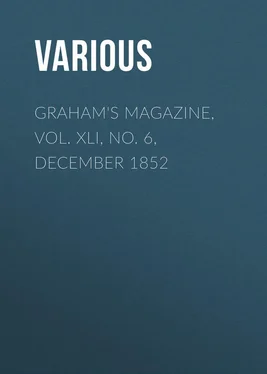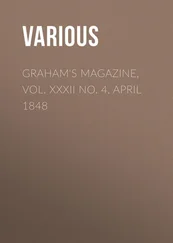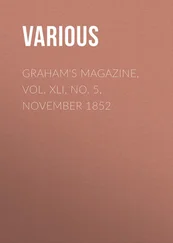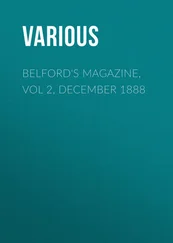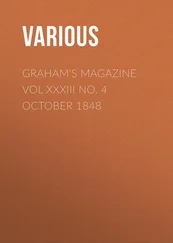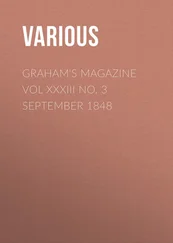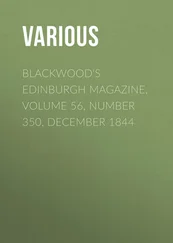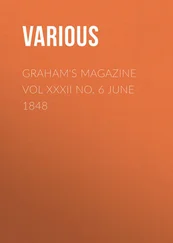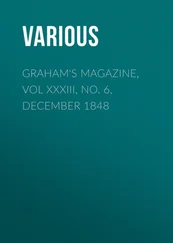Various - Graham's Magazine, Vol. XLI, No. 6, December 1852
Здесь есть возможность читать онлайн «Various - Graham's Magazine, Vol. XLI, No. 6, December 1852» — ознакомительный отрывок электронной книги совершенно бесплатно, а после прочтения отрывка купить полную версию. В некоторых случаях можно слушать аудио, скачать через торрент в формате fb2 и присутствует краткое содержание. Издательство: Иностранный паблик, Жанр: periodic, literature_19, foreign_edu, на английском языке. Описание произведения, (предисловие) а так же отзывы посетителей доступны на портале библиотеки ЛибКат.
- Название:Graham's Magazine, Vol. XLI, No. 6, December 1852
- Автор:
- Издательство:Иностранный паблик
- Жанр:
- Год:неизвестен
- ISBN:нет данных
- Рейтинг книги:3 / 5. Голосов: 1
-
Избранное:Добавить в избранное
- Отзывы:
-
Ваша оценка:
- 60
- 1
- 2
- 3
- 4
- 5
Graham's Magazine, Vol. XLI, No. 6, December 1852: краткое содержание, описание и аннотация
Предлагаем к чтению аннотацию, описание, краткое содержание или предисловие (зависит от того, что написал сам автор книги «Graham's Magazine, Vol. XLI, No. 6, December 1852»). Если вы не нашли необходимую информацию о книге — напишите в комментариях, мы постараемся отыскать её.
Graham's Magazine, Vol. XLI, No. 6, December 1852 — читать онлайн ознакомительный отрывок
Ниже представлен текст книги, разбитый по страницам. Система сохранения места последней прочитанной страницы, позволяет с удобством читать онлайн бесплатно книгу «Graham's Magazine, Vol. XLI, No. 6, December 1852», без необходимости каждый раз заново искать на чём Вы остановились. Поставьте закладку, и сможете в любой момент перейти на страницу, на которой закончили чтение.
Интервал:
Закладка:
This gives a great superiority for purposes of illustration, whether by anagrams or slight sketches of things described in the body of the work, to the wood-cut, above the copper-plate. And, indeed, this admitted advantage, with the extreme comparative cheapness of wood-engraving, and the rare delicacy and beauty which has been attained by the more modern artists of the day, has led to the very general adoption of this style of illustration for ornamented volumes.
It is, in fact, rapidly gaining the preference over metallic engraving; the great expense and very inferior durability of copper, and the coldness, hardness, and absence of richness which seem to be inherent to steel, having gone far to banish both from general use as ornaments or additions to printed books.
As the finest of all methods of reproducing large pictures and fine productions of art; as affording exquisite adornments for the walls of ornamented apartments – vastly superior, would people but believe it, to second-rate oil-paintings – as the legitimate treasures of hoarded portfolios, fine copperplate-engravings will and must ever hold their place. But for the illustration of books – as books must now be – accessible to the million, we fully believe that wood is the best, and soon to be almost the sole material.
The day of steel, 1 1 It may not probably be known to ordinary readers that while a copperplate-engraving begins to fail after two or three thousand copies have been taken from it, and is worthless after six or eight thousand, fifty or sixty thousand can be taken from wood-blocks, and yet more from steel, without detriment.
we think and hope, is already past, for though we have seen good things executed on that most thankless and intractable of substances, we never saw such that we did not regret the time, the talent, and the toil, so comparatively wasted.
Now, to return to the history of wood-cutting proper, we find that but little improvement was effected in the mechanical part, little filling in, very slight efforts at representing texture, and scarcely any chiaro-scuro having been attempted, previous to the invention of movable types and the use of the press.
It is probable that Gutenberg first conceived the idea of movable types, at Strasburg, in or about 1436; and that “with the aid of Faust’s money, and Sheffer’s ingenuity,” 2 2 History Wood Engraving. Jackson. London.
the art was perfected at Mentz in or about 1452. “In the first book which appeared with a date and the printer’s name,” continues the author I have quoted above – “The Psalter printed by Faust and Scheffer at Mentz, in 1457 – the large initial letters, engraved on wood, and printed in red and blue ink, are the most beautiful specimens of this kind of ornament which the united efforts of the wood-engraver and the pressman have produced. They have been imitated in modern times but not excelled. As they are the first letters, in point of time, printed with two colors, so are they likely to continue the first in point of excellence.”
From this time the art made rapid progress, as connected with the press, which in a very rude and primitive state now came generally into vogue, though the machine of 1460 was as far different from one of Hoe’s marvelous power-presses as is an Indian’s bark canoe from an Atlantic steamer.
Between this date and the conclusion of the century, we find one wood-engraving by an unknown author, the frontispiece of Breydenbach’s Travels, so infinitely superior to every thing that succeeded it for many years as to deserve special notice. It contains the first specimen of cross-hatching known to exist, and attempts both shade and color, not without considerable effect. It is said, by the author above quoted, “not to be only the finest wood-engraving up to that date, but to be in point of design and execution as far superior to the best cuts in the Nuremberg Chronicle, as Albert Durer’s designs are to the cuts in the oldest edition of the ”Poor Preacher’s Bible.“ The engraved frontispiece, in question, bears the date 1486, the Nuremberg Chronicle of 1493; and the Biblia Pauperum , as it is – probably erroneously – called, in various editions from 1462 to 1475.”
The following cut is a representation of the press in use at this period, and for some considerable time afterward. It is a fac-simile of an engraving of “the press of Jodocus Badius Ascensianus, from the title page of a book printed by him in 1498.”
The above engraving, although it is not inserted here as a specimen of the style of engraving at this date, but merely as a representation of the machinery in use at the time, may be regarded, on the whole, as about on an average with the ordinary work of the period, both as to design and execution; it is vastly superior to the cuts of the “ Biblia Pauperum ,” and “ Speculum Humanæ Salvationis ,” and yet more so to that of the Nuremberg Chronicles; it is inferior to the frontispiece of Breydenbach’s Travels, which, it has been stated above, is the chef-d’œuvre of this epoch; but, although slight and sketchy, it is in all respects superior to the hideous monstrosities which disgrace, in lieu of ornamenting, four-fifths of the cheap publications of the day.
We have now, however, arrived at a period when wood-engraving became not merely a calling, but an art; when painters of the highest degree, higher than ever before or since, were proud and pleased, and, what is more, able to be designers on wood for the engravers. From this date, until the troubles of the civil war and commonwealth in England, and religious conflicts on the continent of Europe, annihilated the arts, put the muses to flight – with one sublime exception – and almost overthrew society itself, such painters as Wolgemuth, and Pleydenwurth, Cranach, and Burgmair, and more famous yet, Albert Durer and Hans Holbein, became the chief patrons and promulgators of the art, constantly themselves designing and completing drawings on wood, for the engraver, although there is no reason for believing – but on the contrary every reason for denying – that these illustrious men ever employed themselves in actual cutting; which was then a process purely mechanical, practiced by persons utterly devoid of all knowledge either of composition or correct drawing. At this time, all the merit of the wood-cut rested with the designer and artist, none with the wood-cutter. Now it is shared by both alike, and to produce an excellent wood-engraving, excellence both in the artist and the engraver is indispensable. Of a bad or indifferent 3 3 As an exemplication of the above statement, two wood-cuts are here submitted, with the view of proving the absolute necessity of a good artist-like drawing to enable the engraver to produce a handsome or even creditable wood-cut. Both the following cuts are from one sketch, by the great landscape-painter Morland – the one meagre, tame, unfilled, and presenting nothing beyond a bare, cold outline; the other a remarkably spirited and flowing sketch, not one of the extra or additional lines being supernumerary, but each tending to give both effect and support to the outline.
4 4 And here it is well to point out to those seeking to obtain good wood-engravings, for the illustration of works which they propose to write or publish, that there are two absurdities, about equally great, usually committed by persons in their position. The one of which is the ordering and paying liberally for the work of a clever artist and designer, and then mulcting the engraver one half the price he ought to receive, if he do his duty and spend the requisite time on the work, and wondering why the product is a wretched botch and not a fine work of art. The other is the converse of this, paying an engraver well to cut, and grudging the extra expense of a good artist. For it must be remembered, that in wood-engraving the artist and designer, where they are not one, as in the case of Bewick and a few others – and this is a rare case – must work in unity of intent, with a perfect comprehension of, and a full sympathy in, the meaning and genius each of the other.
composition and design, the best engraver that ever lived cannot make a good picture. And in no smaller degree will the best picture ever composed and drawn by the best artist be ruined, and prove an utter failure, if intrusted to the hands of an ignorant, incompetent, or reckless engraver.
Интервал:
Закладка:
Похожие книги на «Graham's Magazine, Vol. XLI, No. 6, December 1852»
Представляем Вашему вниманию похожие книги на «Graham's Magazine, Vol. XLI, No. 6, December 1852» списком для выбора. Мы отобрали схожую по названию и смыслу литературу в надежде предоставить читателям больше вариантов отыскать новые, интересные, ещё непрочитанные произведения.
Обсуждение, отзывы о книге «Graham's Magazine, Vol. XLI, No. 6, December 1852» и просто собственные мнения читателей. Оставьте ваши комментарии, напишите, что Вы думаете о произведении, его смысле или главных героях. Укажите что конкретно понравилось, а что нет, и почему Вы так считаете.
